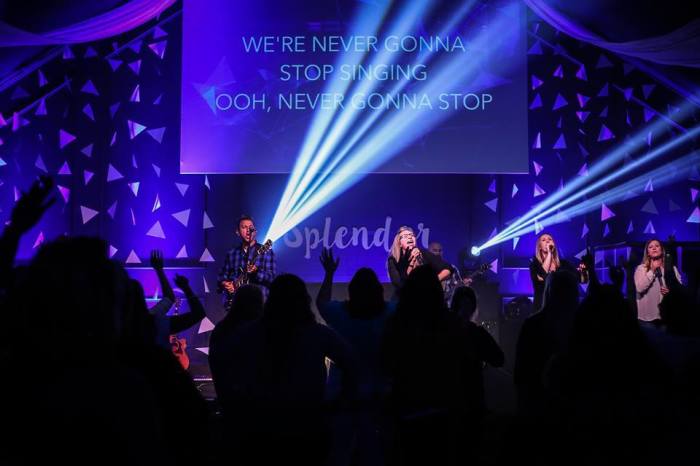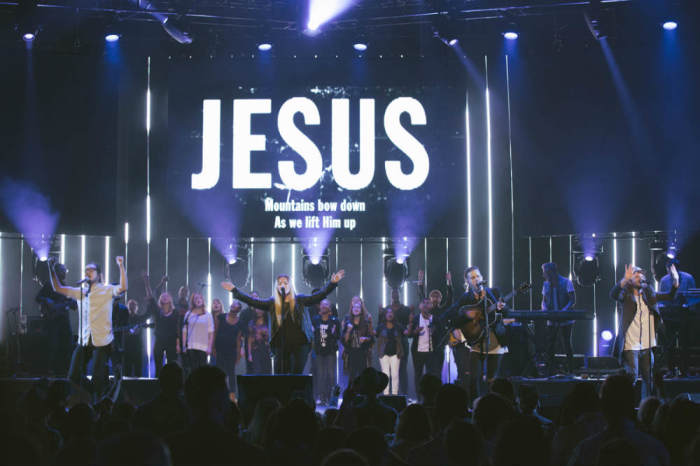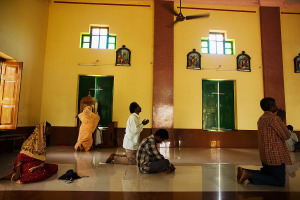Creative Worship Services Drawing the Young, but Some Worry It's Going Too Far

At Embassy Church International in Atlanta, worship isn't just hand-clapping, solemn hymns and shouts of praise anymore.
In the last five years, traditional liturgy has evolved into Holy Spirit-driven, multisensory events where fog, concert lights, prophetic paintings and aerialist performances are all used to help usher churchgoers into "incredible" encounters with God.
"We've had some incredible experiences with fog," said Ajani Brown, Embassy Church International's pastor of operations.
"We have very high energetic worship services where we experience just all types of healing [and] miracles. So not only do they (congregants) get a high level of creativity but they also get raw presence and raw glory," he said. "We've had so many testimonies of people set free and delivered just by what we offer in our ministry and we're excited. We are taking creativity really to the next level in the church."
Embassy Church International began in a living room with just 12 people five years ago. They were mostly college graduates hailing from different Christian traditions. For almost two years, that fellowship was stuck at just 11 people. It eventually grew to 30 people "and all we did was worship," Brown explained.
Since the introduction of creative technology to worship services, like concert lights and fog, weekly attendance at Embassy Church International has mushroomed to approximately 400.
"For a long time we did not have fog in our services. We did not have lights in our services. We had great content. We had the music, we had the songs, we had the liturgy. We had all of that. What lighting, what fog did was it helped bring the worshiper into a context of what was happening. It helped make sense of what was occurring because they (millennial Christians) are visual learners," said Brown.
Innovation and Church Growth
Recent research highlighted by Church Leaders says that over the last four decades, churches have been reporting a slow decline in the number of people who regularly attend church services. In 2018, it's estimated that less than 20 percent of Americans regularly attend church.

Findings from American Congregations 2010 suggest that mainline and conservative Protestant churches could experience growth by adopting innovative worship and contemporary worship styles. Researchers found that congregations in these traditions that adopted innovative worship were significantly more likely to increase their numbers, especially with the young.
And Brown and his colleagues at Embassy Church International have been working hard to promote a similar message.
On April 7, for the second year in a row, Embassy Church International hosted its CREATE Conference. The church called it "an unconventional confluence of the arts, culture, media, entertainment, and technology" to help creatives use their artistic gifts in ministry.
"We weren't looking to become this next big church," Brown said. "We weren't looking to become this next big thing, [but] people were experiencing emotional, physical and mental healing and that is still what we're about."
While current research shows that innovative worship services rich with technology like artificial fog and concert lights can be used to help grow churches, some worship experts and longtime Christians are concerned about what they see as a danger to sound worship theology.
Concerns in Worship
When Apostle Bryan Meadows, Embassy Church's lead pastor, announced plans in April to make aerialist performances a regular feature at the church's worship service, Ann Brock, a longtime blogger on issues in the black church, said it was a step too far.
"I'm afraid we have strayed far from worship for the sake of entertainment. I of all people believe God the Creator made us in his image. He being Creator made us creative. However, there has been a recent burden of what our 'worship' services are becoming. In an attempt to compete with the world's presentation we have flooded the church with lights, stages and performances. I'm all for creative expression but what happens when the PRODUCTION overshadows the PRAISE?"
Approximately two weeks before he announced his decision to resign as lead pastor of Quest Church in Seattle on June 3, Eugene Cho also publicly lamented on Twitter what he feels is a growing overreliance on technology in worship services.
"I'm convinced that in the Church today, we need less spotlights, fog machines, formulas and simply more humility and dependence on the presence and power of the Holy Spirit," Cho tweeted.
His comment quickly set off a contentious debate about worship styles and relevance to current culture, forcing Cho to elaborate on his criticism.
"It's not my intent to debate about worship styles. Production and environment have their place and value. It just seems dangerous that from my perspective, much of our focus are about growth, production, environment. We seem to have a Trinitarian theology without the Holy Spirit."

Harry L. Reeder III, senior pastor of Briarwood Presbyterian Church in Birmingham, also knocked what he sees as the growing "entertainment dynamic" in a YellowHammer interview.
"We introduce video cuts, we introduce drama, we introduce dance and we introduce all of these things which, actually, I have no issue with in, let's say, an outreach event or a concert or something like that. However, worship is something different. Worship is something unique and wholly other," he argued.
"... In our effort to be entertaining, we have cut back on the message and we have cut back on our worship in order for it to be just a simple gathering of entertainment where everybody feels good and has a great experience and, 'By the way, won't you come back to be a part of this church?'
"Well, the objective of Christianity is not for people to become a part of our church. The objective of Christianity is for the church to present Christ in all of His glory — that means His transcendence as well as His imminence. That means not only the simplicity of our intimate relationship with Him, but the majesty of our transcendent relationship with Him," Reeder said.
In Defense of Technology
Brown said he understands that criticism well and believes that while concerns about the use of technology in worship services are valid, it represents an issue of personal preference stemming from a generational or cultural divide, not a biblical one.
His church fully understands technology doesn't save souls, he said, but it's helping to draw a new generation of people through the doors of the church.
"I think that when people are coming into our experiences, people are visual. They are visual learners they are kinesthetic learners and we have to figure out how to meet them where they are," he said.
"The church is not just here to bring souls into a box, but the church is here to advance in every sector of society. And if we don't have that in our pulpit, we're not showing that and showcasing that in our churches, then we're [going to] begin to feel like we are not who we say we are, that we're just bringing people into a box and keeping them there until Jesus comes back; that's not what Jesus told us to do.
"Jesus told us to occupy until He comes. And so by doing this we are showing the fruit of our occupation. We are showing the fruit of our assignment to go ye therefore into all the world and share the Good News and the Gospel of Jesus Christ. We can't be stuck in Jerusalem. We've got to go to Judea. We've got to go to the uttermost parts of the Earth."
In American Congregations 2015: Thriving and Surviving, David A. Roozen of the Hartford Institute for Religion Research noted that the descriptors most strongly associated with church growth are "joyful," "innovative," and "inspirational." Other descriptors included "thought provoking" and "filled with a sense of God's presence."
A sense of being "reverent," which many traditional Christians prefer, was not related to growth at all.
"Clearly, the character of worship as celebration rather than lament is important to encouraging the growth of a congregation," Roozen wrote.
Worship Theology
While Jon Choi, director for the master's program in worship studies at Dallas Baptist University's Graduate School of Ministry doesn't see technologically-enhanced worship as inherently bad, he is concerned about what it means for worship theology.
"I think if there is genuine worship going on, I don't think it matters what we use. But many times, since the doctrinal teaching is lacking, a lot of people use that one worship experience as something that's substantial. But just worship [song] lyrics alone, sometimes even the lyrics are not biblical or biblically accurate, so there is definitely that aspect," said Choi, who has also been a pastor for 14 years.
"I don't see a problem with lighting and production [at worship services], but I do see a problem if they do that and that doesn't translate into healthy discipleship that encourages believers to live out as worshipers daily in a non-singing environment," Choi explains. "[If] they are relying on that one experience on a Sunday with all these lights and everything and they just like that, then definitely that's just a facade. They just like the style rather than true worship. True worship is not just on Sunday."
The Rev. Jon. R. Black, pastor of Campbell Chapel African Methodist Episcopal Church in Bluffton, South Carolina, said he and his denomination have been wary of innovative technology in worship also.
"I'm in the wait and see phase. My particular denomination, the AME church, we are a little slower to adapt to some of the new technologies, so we haven't had the impact some of the other congregations have had. We [have been] a little leery doing some of the things we see in other churches so that gives us a little more time to evaluate the process," he said.
"It's the notion of you open up a certain style of worship that almost instantly your building is filled, but you may not have built a Christian community in the process. And I think that's the key — to build community. So if we can use technology to build community that's great. But if we're just forming gatherings then I think we miss the boat. It has to be this notion of forming community," Black explained.
Membership in Black's historic church currently stands at about 270 in a town of 30,000.
Despite being wary of technologically-enhanced worship services, when pointed to research that shows adopting innovation in worship can be helpful, the Princeton Theological Seminary graduate said he has seen positive signs of that innovation in his own community.
"We have one megachurch, Low Country Community Church, they have all the bells and whistles. I do think you're right," he said of the research.
"They are more of a biblically based congregation than some of the [other] megachurches and I've talked to their members who show really wonderful signs of spiritual maturity. Something good is happening there and we are appreciative of them."
When asked if he ever considered introducing innovations like concert lights or fog to his services, he said the church has added some technology over the years but not necessarily to attract new members.
"We have screens that we use for scriptures and hymns. We have the cameras going for that purpose. But we didn't change our worship style. This was for those who preferred to look up instead of having a bulletin, to reduce our carbon footprint a little bit. ... So it's just a little bump in technology for us and I think that's probably typical for most AME churches," he said. "We haven't made that postmodern turn where we have the praise band and those kind of things going on."




























